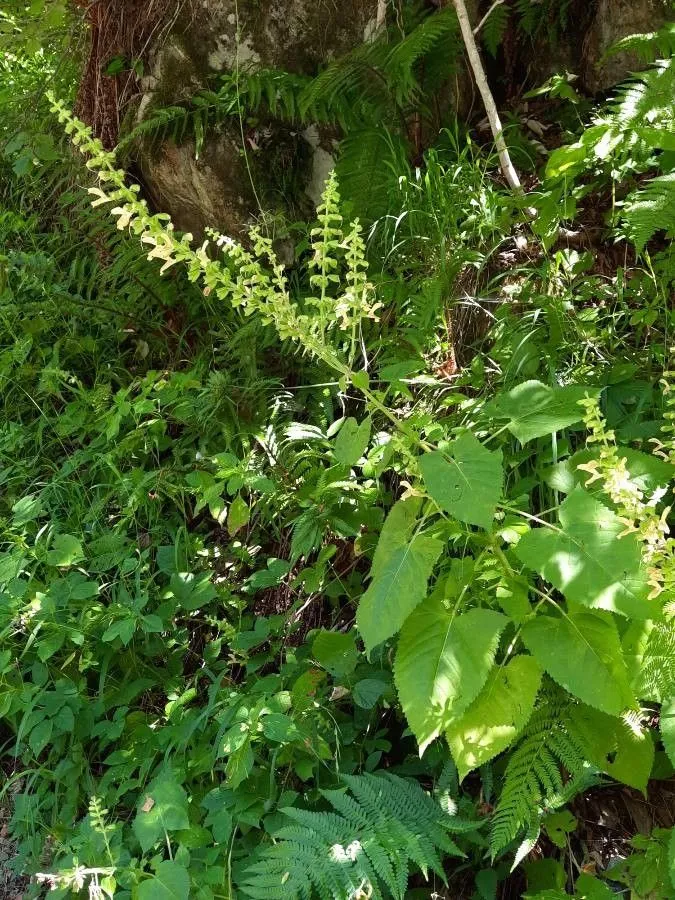
Author: L.
Bibliography: Sp. Pl.: 26 (1753)
Year: 1753
Status: accepted
Rank: species
Genus: Salvia
Vegetable: False
Observations: Europe to Iran
Jupiter’s distaff, known scientifically as Salvia glutinosa, is a captivating species within the Lamiaceae family. This robust perennial herb is admired not only for its striking appearance but also for its adaptability across a broad range of habitats. Its native distribution spans from Europe to Iran, showcasing its resilience and versatility in various climatic conditions.
Characterized by its sticky, glandular leaves and stems, Salvia glutinosa often displays an impressive array of pale yellow flowers that may have reddish or purplish markings. The plant’s common name, “Jupiter’s distaff,” alludes to the mythological connotations and its historical significance across cultures within its native range.
Typically found in deciduous forests, edges of woodlands, and along shaded trails, Salvia glutinosa thrives in conditions ranging from full sun to partial shade. Its preference for well-drained soils with moderate fertility allows it to flourish in both cultivated gardens and wild environments. As a member of the Lamiaceae family, it shares common traits with other culinary and medicinally significant sages, although its primary use is ornamental.
The plant’s introduction to scientific literature dates back to 1753, referenced in “Species Plantarum” by the renowned botanist Carl Linnaeus, marked by the abbreviation “L.”. This early classification highlights the longstanding botanical interest and the comprehensive efforts to document and understand the diverse flora of the world.
In gardens, Salvia glutinosa is appreciated for its long blooming period, which extends from summer into early fall, providing continuous aesthetic appeal and attracting a variety of pollinators, including bees and butterflies. Its ability to naturalize in a variety of settings makes it a favorite among gardeners looking to create a low-maintenance, yet visually appealing landscape.
In summary, Jupiter’s distaff (Salvia glutinosa) stands out as a remarkable plant with significant horticultural and ecological value. Its history, spanning from Europe to Iran, combined with its elegant floral display and robust nature, continues to enchant botanists and garden enthusiasts alike.
Eng: jupiter’s distaff, sticky clary, sticky sage
Deu: klebriger salbei
Lit: lipnusis šalavijas
Swe: klibbsalvia
Fra: sauge glutineuse
Cym: clari gludiog
En: Jupiter’s distaff, Sticky clary, Sticky sage, Jupiter’s sage, Glutinous sage, Hardy sage, Yellow Sage
Bg: Жълт конски босилек
Ca: Sàlvia glutinosa
Zh: 胶质鼠尾
Hr: Ljepljiva kadulja
Cs: Šalvěj lepkavá
Da: Klæbrig Salvie
Nl: Kleverige salie
Et: Kollane salvei
Fi: Keltasalvia
Fr: Sauge glutineuse, Sauge poisseuse, Ormin gluant
De: Klebriger Salbei, Kleb-Salbei, Klebkraut
It: Salvia vischiosa
Lt: Lipnusis šalavijas
Fa: مریمگلی جنگلی
Pl: Szałwia lepka
Ru: Шалфей железистый, Или Шалфей клейкий
Sk: Šalvia lepkavá
Es: Lepljiva kadulja
Sv: Klibbsalvia
Zh-tw: 膠質鼠尾
Zh-hant: 膠質鼠尾
Tr: Yapışkan adaçayı
Cy: Clari gludiog
Taken Jul 25, 2011 by Tela Botanica − Yoan MARTIN (cc-by-sa)
Taken Aug 11, 2014 by Tela Botanica − Anny RAIM (cc-by-sa)
Taken Jul 25, 2011 by Tela Botanica − Yoan MARTIN (cc-by-sa)
Taken Sep 3, 2020 by Hélène Marginédes (cc-by-sa)
Taken Aug 23, 2021 by Daniel Barthelemy (cc-by-sa)
Taken Sep 4, 2022 by ana radin (cc-by-sa)
Taken Sep 6, 2020 by André Hyvrier (cc-by-sa)
Taken Jul 28, 2018 by Dieter Wagner (cc-by-sa)
Taken Jul 28, 2018 by Dieter Wagner (cc-by-sa)
Taken Jul 28, 2018 by Dieter Wagner (cc-by-sa)
Taken Aug 23, 2021 by Daniel Barthelemy (cc-by-sa)
Taken Aug 23, 2021 by Daniel Barthelemy (cc-by-sa)
Taken Aug 23, 2021 by Daniel Barthelemy (cc-by-sa)
Taken Nov 2, 2020 by Dieter Wagner (cc-by-sa)
Taken Sep 3, 2020 by Hélène Marginédes (cc-by-sa)
Taken Sep 26, 2022 by Joey F (cc-by-sa)
Taken Aug 24, 2015 by Tela Botanica − Ruddy BENEZET (cc-by-sa)
Taken Jul 24, 2011 by Tela Botanica − Yoan MARTIN (cc-by-sa)
Taken Jun 8, 2022 by grutz (cc-by-sa)
Taken Jul 24, 2011 by Tela Botanica − Yoan MARTIN (cc-by-sa)
Taken Jun 30, 2022 by Pierre Meunier (cc-by-sa)
Taken Jul 23, 2021 by Michael Curran (cc-by-sa)
Taken Sep 26, 2022 by Joey F (cc-by-sa)
Taken Jul 7, 2022 by Fabrice Rubio (cc-by-sa)
Taken Sep 14, 2019 by Pietro Brignoli (cc-by-sa)
© copyright of the Board of Trustees of the Royal Botanic Gardens, Kew.
© copyright of the Board of Trustees of the Royal Botanic Gardens, Kew.
© copyright of the Board of Trustees of the Royal Botanic Gardens, Kew.
Taken Oct 29, 2022 by Sylvain Gaudin (cc-by-sa)
Taken Sep 27, 2019 by Davide Di Censo (cc-by-sa)
Taken Sep 22, 2021 by Christoph Zirwes (cc-by-sa)
Taken Sep 8, 2018 by bas yves (cc-by-sa)
Taken Jul 26, 2022 by Anatas (cc-by-sa)
Growth habit: Forb/herb
Ph maximum: 7.5
Ph minimum: 7.0
Light: 4
Atmospheric humidity: 7
Bloom months: [‘jun’, ‘jul’, ‘aug’, ‘sep’]
Soil nutriments: 7
Family: Myrtaceae Author: (F.Muell.) K.D.Hill & L.A.S.Johnson Bibliography: Telopea 6: 402 (1995) Year: 1995 Status:…
Family: Rubiaceae Author: Pierre ex A.Froehner Bibliography: Notizbl. Bot. Gart. Berlin-Dahlem 1: 237 (1897) Year:…
Family: Sapindaceae Author: Koidz. Bibliography: J. Coll. Sci. Imp. Univ. Tokyo 32(1): 38 (1911) Year:…
Family: Asteraceae Author: A.Gray Bibliography: Pacif. Railr. Rep.: 107 (1857) Year: 1857 Status: accepted Rank:…
Family: Fabaceae Author: Medik. Bibliography: Vorles. Churpfälz. Phys.-Ökon. Ges. 2: 398 (1787) Year: 1787 Status:…
Family: Aspleniaceae Author: (Cav.) Alston Bibliography: Bull. Misc. Inform. Kew 1932: 309 (1932) Year: 1932…